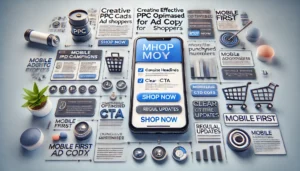Optimising Your Ecommerce PPC Campaigns for UK Mobile Shoppers

In today’s fast-paced world, mobile devices have become an essential part of our daily lives. For online businesses, especially in the UK, this shift means it’s crucial to focus on mobile first marketing. This article will guide you on how to optimise your ecommerce PPC campaigns for mobile shoppers, ensuring you reach your audience effectively and boost your sales.
Key Takeaways
- Mobile first marketing is essential for reaching today’s consumers who primarily use mobile devices.
- Understanding mobile shopping trends in the UK can help tailor your marketing strategies.
- Optimising your ecommerce site for mobile users improves user experience and increases conversions.
- Effective PPC campaigns for mobile shoppers require mobile-optimised ad copy and bidding strategies.
- Leveraging social media platforms like Facebook, Instagram, and TikTok can enhance your mobile first marketing efforts.
Understanding Mobile First Marketing
The Importance of Mobile First Marketing
In today’s digital age, focusing on mobile first marketing is essential. With more people using their smartphones to shop online, we need to ensure our ecommerce strategies are tailored for mobile users. Mobile first marketing means designing our campaigns with mobile users in mind from the start, rather than adapting desktop campaigns for mobile later. This approach helps us reach our audience more effectively and provides a better user experience.
How Mobile First Marketing Differs from Traditional Marketing
Mobile first marketing is different from traditional marketing in several ways. Traditional marketing often focuses on desktop users, while mobile first marketing prioritises mobile users. This means we need to consider factors like smaller screen sizes, touch navigation, and faster load times. Additionally, mobile users tend to have different browsing habits and preferences compared to desktop users. By understanding these differences, we can create more effective marketing campaigns that resonate with our mobile audience.
Key Benefits of Mobile First Marketing for Ecommerce
There are several key benefits to adopting a mobile first marketing approach for ecommerce. Firstly, it allows us to reach a larger audience, as more people are using their mobile devices to shop online. Secondly, it can lead to higher conversion rates, as mobile-optimised sites and ads provide a better user experience. Finally, mobile first marketing can help us stay ahead of the competition by ensuring our campaigns are up-to-date with the latest trends and technologies.
Embracing mobile first marketing is not just a trend; it’s a necessity for any ecommerce business looking to thrive in today’s market.
By focusing on mobile first marketing, we can create more engaging and effective campaigns that drive better results for our ecommerce business.
Analysing Mobile Shopping Trends in the UK
Current Mobile Shopping Statistics
Mobile commerce, or m-commerce, is on the rise in the UK. By 2025, it’s expected to surpass £100 billion. In 2023, 100% of people aged 16 to 54 own a smartphone, making it their first choice for purchases. Interestingly, 69% of online shoppers use a mobile device compared to 43% who use a laptop.
Consumer Behaviour Insights
Consumers are more likely to complete an order after adding items to their cart on a mobile device than on a desktop. They also prefer browsing websites on mobile or tablet devices. Despite this, the average order value worldwide is higher on desktop than on mobile. Shoppers want faster delivery and free returns, showing a demand for near-instant gratification.
Impact of Mobile Shopping on Ecommerce
The rise of mobile shopping has a significant impact on ecommerce. Businesses need to adopt eco-friendly practises as 74% of consumers care about the environmental impact of their purchases. Additionally, 68% are willing to pay more for environmentally friendly products. Personalisation is also crucial, with modern consumers expecting tailored shopping experiences. Using data analytics to understand individual preferences can greatly enhance customer satisfaction and loyalty.
Keeping a pulse on ever-shifting consumer trends is crucial for ecommerce businesses to stay competitive and meet customer expectations.
Optimising Your Ecommerce Site for Mobile Users
Responsive Design Best Practises
Optimising your online store for mobile users is more crucial than ever. With the majority of internet browsing done on mobile devices, your ecommerce site must cater specifically to the needs of these users. This means more than just having a responsive design; it’s about creating an entire shopping experience with mobile in mind. For instance, enlarging the ‘Add to Cart’ button on product pages can significantly reduce frustration and improve the user experience, making it easier for mobile users to make purchases without the need to zoom in or struggle with navigation.
Improving Mobile Load Times
Furthermore, optimising images for mobile is essential. Mobile users expect fast loading times and images that are easy to view on smaller screens. By presenting your images in a mobile-friendly format, you can ensure that your products are displayed clearly, making it easier for customers to make purchase decisions. Remember, the goal is to create a seamless and enjoyable shopping experience from start to finish, encouraging users to return to your site time and again.
Mobile-Friendly Navigation Tips
To master ecommerce marketing, you must leverage a variety of tactics that span across multiple channels. This includes a blend of advertising, email marketing, SEO, and social media strategies to create a consistent and integrated experience. Understanding that ecommerce marketing is not just about promoting products but also about creating a journey for your customers is key. By aligning your marketing channels and employing a holistic multichannel marketing strategy, you can ensure that every touchpoint along the customer journey is engaging and cohesive, driving better results for your ecommerce business.
Creating Effective PPC Campaigns for Mobile Shoppers
Crafting Mobile-Optimised Ad Copy
When it comes to mobile shoppers, ad copy must be concise and engaging. We need to focus on the unique selling points of our products. Short, punchy headlines work best. Including a clear call-to-action (CTA) is crucial. For instance, phrases like “Shop Now” or “Get Yours Today” can drive immediate action. Regularly updating ad copy ensures it stays relevant and aligned with current trends.
Utilising Mobile-Specific Ad Extensions
Ad extensions can significantly enhance the visibility of our ads. Mobile-specific extensions, such as call buttons or location extensions, make it easier for users to interact with our business. These extensions provide additional information without cluttering the main ad text. For example, a call button allows users to contact us directly from the ad, improving the user experience.
Best Practises for Mobile PPC Bidding
Bidding strategies for mobile PPC campaigns should be tailored to maximise ROI. We should consider using automated bidding options provided by platforms like Google AdWords PPC. These tools adjust bids in real-time based on the likelihood of a conversion. Additionally, setting bid adjustments for mobile devices can help prioritise ad spend where it’s most effective. Regularly reviewing and tweaking bids ensures optimal performance.
Effective content not only attracts users but also guides them towards making a purchase, making it a critical component of successful PPC campaigns.
By following these strategies, we can create PPC campaigns that are not only effective but also tailored to the needs of mobile shoppers. This approach ensures that our ads are seen by the right audience at the right time, driving better results for our ecommerce business.
Leveraging Google Ads for Mobile First Marketing
Setting Up Mobile-Optimised Google Ads
When setting up Google Ads for mobile, we need to ensure our ads are tailored for smaller screens. This means using concise, engaging ad copy and high-quality images. Mobile users are often on the go, so our ads must grab their attention quickly. We should also make sure our landing pages are mobile-friendly, with fast load times and easy navigation.
Using Google Analytics for Mobile Insights
Google Analytics is a powerful tool for understanding how mobile users interact with our site. By analysing metrics like bounce rate, session duration, and conversion rate, we can identify areas for improvement. For instance, if we notice a high bounce rate on mobile, it might indicate that our site isn’t user-friendly. Regularly reviewing these insights helps us refine our strategy and improve our expected CTR.
Advanced Google Ads Strategies for Mobile
To get the most out of our mobile PPC campaigns, we should consider advanced strategies like remarketing and audience segmentation. Remarketing allows us to target users who have previously visited our site, increasing the chances of conversion. Audience segmentation helps us tailor our ads to specific groups, making them more relevant and effective. Additionally, we can use ad extensions like call buttons and location information to make it easier for mobile users to engage with our business.
By leveraging these advanced strategies, we can significantly enhance the performance of our mobile PPC campaigns, driving more traffic and conversions.
In conclusion, optimising Google Ads for mobile is crucial for reaching today’s mobile-first shoppers. By focusing on mobile-friendly ad setups, utilising Google Analytics, and implementing advanced strategies, we can create effective campaigns that resonate with mobile users.
The Role of Social Media in Mobile First Marketing
Utilising Facebook and Instagram Ads
Social media is a powerful tool for reaching mobile shoppers. Platforms like Facebook and Instagram offer targeted advertising options that can help us connect with potential customers. By using these ads, we can drive traffic directly to our ecommerce site. It’s not just about selling products; it’s about engaging with our audience. We can create content that resonates with them and builds a community around our brand.
Exploring TikTok for Ecommerce
TikTok is rapidly becoming a favourite among younger audiences. This platform allows us to create short, engaging videos that showcase our products in a fun and creative way. By leveraging TikTok, we can reach a new demographic and turn viewers into customers. The key is to be authentic and relatable, which can significantly boost our brand’s visibility.
Integrating Social Media with PPC Campaigns
Combining social media efforts with PPC campaigns can maximise our reach. We can use data from our social media interactions to refine our PPC strategies, ensuring that our ads are seen by the right people. This integrated approach helps us to create a seamless experience for our customers, from social media engagement to final purchase.
By leveraging social media platforms effectively, we can enhance our mobile first marketing strategy and drive better results for our ecommerce business.
Enhancing User Experience for Mobile Shoppers
Streamlining the Mobile Checkout Process
We all know how frustrating a complicated checkout process can be. To keep our customers happy, we need to make it as simple as possible. This means reducing the number of steps required to complete a purchase and ensuring that forms are easy to fill out on a mobile device. Offering multiple payment options can also help, as it allows customers to choose the method they are most comfortable with.
Personalising Mobile Shopping Experiences
Personalisation is key to making our customers feel valued. By using data analytics, we can understand individual preferences and tailor the shopping experience accordingly. This might include personalised product recommendations or customised marketing messages. The goal is to make each customer feel like the shopping experience was designed just for them.
Using Push Notifications Effectively
Push notifications can be a powerful tool if used correctly. They can remind customers about items left in their cart, inform them about special offers, or provide updates on their order status. However, it’s important not to overdo it. Too many notifications can become annoying and may lead to customers disabling them altogether. Finding the right balance is crucial for maintaining a positive user experience.
Remember, the goal is to create a seamless and enjoyable shopping experience from start to finish, encouraging users to return to your site time and again.
Measuring the Success of Mobile First Marketing Campaigns
Key Metrics to Track
To gauge the success of our mobile first marketing campaigns, we need to focus on several key metrics. Conversion rate is crucial as it tells us how many visitors are turning into customers. Another important metric is bounce rate, which shows how many users leave our site after viewing just one page. Additionally, tracking the average session duration can provide insights into user engagement.
Tools for Measuring Mobile Campaign Performance
We have a variety of tools at our disposal to measure the performance of our mobile campaigns. Google Analytics is a powerful tool that offers detailed insights into user behaviour. Another useful tool is SEMrush, which helps us understand our traffic patterns and user engagement. Hotjar can also be beneficial for visualising user interactions on our site.
Interpreting Data for Continuous Improvement
Once we have gathered data, the next step is to interpret it for continuous improvement. By analysing the data, we can identify what’s working and what isn’t. This allows us to make informed decisions and adjust our strategies accordingly. Remember, the goal is to turn insights into action, refining our marketing efforts to drive better results.
Measuring success is not just about collecting data; it’s about understanding it and using it to make better decisions.
Future Trends in Mobile First Marketing
The Rise of Voice Search
Voice search is becoming more common. People are using their smart speakers and phones to search for products. This means we need to optimise our content for voice queries. Voice search is changing how customers find what they need.
AI and Machine Learning in Mobile Marketing
Artificial intelligence (AI) and machine learning are making mobile marketing smarter. These technologies help us understand what customers want. We can offer personalised shopping experiences. This makes our marketing more effective.
Privacy and Data Protection Considerations
Consumers care about their privacy. They want to know how their data is used. We must be transparent about our data practises. This builds trust and keeps customers coming back.
Staying ahead of these trends ensures our e-commerce business remains competitive and relevant.
Common Challenges in Mobile First Marketing and How to Overcome Them
Dealing with Mobile Ad Fraud
Mobile ad fraud is a significant issue that can drain your marketing budget. Fraudsters use techniques like click spamming and fake installs to exploit your campaigns. To combat this, we must employ advanced fraud detection tools and regularly monitor our ad performance. Implementing strict verification processes can also help in identifying and eliminating fraudulent activities.
Overcoming Technical Limitations
Technical limitations, such as slow load times and poor mobile optimisation, can hinder user experience. It’s crucial to ensure our ecommerce site is fully optimised for mobile devices. This includes using responsive design, compressing images, and leveraging browser caching. By addressing these technical challenges, we can provide a seamless shopping experience for our mobile users.
Ensuring Cross-Device Compatibility
Cross-device compatibility is essential for a smooth user journey. Shoppers often switch between devices, and our site must offer a consistent experience across all platforms. We should test our site on various devices and browsers to identify and fix any compatibility issues. Utilising responsive design and adaptive content strategies can significantly enhance cross-device compatibility.
Addressing these common challenges in mobile first marketing is crucial for the success of our ecommerce PPC campaigns. By staying vigilant and proactive, we can ensure a better user experience and higher conversion rates.
Case Studies of Successful Mobile First Marketing Campaigns
Retail Industry Success Stories
In the retail industry, mobile first marketing has shown remarkable results. One notable example is a leading UK retailer that revamped its mobile shopping experience. By integrating a new shopping button within their app, they streamlined the purchasing process. This update not only enhanced user experience but also significantly boosted sales. Mobile first strategies have proven to be a game-changer in retail.
Innovative Approaches in Fashion Ecommerce
Fashion ecommerce brands have also embraced mobile first marketing with innovative approaches. A prominent fashion brand utilised mobile-specific ad extensions to target their audience more effectively. They saw a substantial increase in click-through rates and conversions. The key takeaway here is the importance of tailoring your marketing efforts to suit mobile users.
Lessons Learned from Leading Brands
Leading brands across various sectors have shared valuable lessons in mobile first marketing. One common theme is the emphasis on creating a seamless and enjoyable shopping experience. By focusing on mobile-friendly navigation and fast load times, these brands have managed to keep their customers engaged and satisfied. Optimising for mobile is not just a trend; it’s a necessity for success in today’s digital landscape.
Embracing mobile first marketing can transform your ecommerce business, driving growth and customer satisfaction.
Explore our “Case Studies of Successful Mobile First Marketing Campaigns” to see how top brands have transformed their marketing strategies. These real-world examples show the power of mobile-first approaches in driving engagement and sales. Ready to boost your own campaigns? Visit our website for a free PPC audit and expert advice tailored to your needs.
Conclusion
In summary, focusing on mobile-first marketing for your eCommerce PPC campaigns is essential in today’s UK market. With more shoppers using their mobile devices to browse and buy, optimising your campaigns for mobile can lead to better engagement and higher sales. By understanding your audience, using the right keywords, and continually testing your ads, you can create effective PPC campaigns that drive results. Remember, staying updated with the latest trends and tools will keep you ahead of the competition. Embrace the mobile-first approach and watch your eCommerce business grow.
Frequently Asked Questions
What is mobile first marketing?
Mobile first marketing is a strategy that prioritises mobile users when creating marketing campaigns. It means designing ads, websites, and content with mobile devices in mind first, before considering desktops.
Why is mobile first marketing important for ecommerce?
Mobile first marketing is vital for ecommerce because more and more people are shopping on their mobile devices. By focusing on mobile users, businesses can reach a larger audience and improve their shopping experience.
How does mobile first marketing differ from traditional marketing?
Traditional marketing often focuses on desktops and larger screens, while mobile first marketing puts mobile users at the forefront. This includes using responsive designs, faster load times, and mobile-friendly navigation.
What are the benefits of mobile first marketing for ecommerce?
The benefits include reaching a wider audience, improving user experience, increasing conversion rates, and staying competitive in a mobile-centric world.
How can I optimise my ecommerce site for mobile users?
You can optimise your site by using responsive design, ensuring fast load times, and creating easy-to-use navigation. This helps provide a better shopping experience for mobile users.
What are some tips for creating mobile-optimised PPC campaigns?
To create mobile-optimised PPC campaigns, focus on short and clear ad copy, use mobile-specific ad extensions, and adjust your bidding strategy for mobile users.
How can I measure the success of my mobile first marketing campaigns?
You can measure success by tracking key metrics like click-through rates, conversion rates, and mobile traffic. Tools like Google Analytics can help you gather and analyse this data.
What are the future trends in mobile first marketing?
Future trends include the rise of voice search, the use of AI and machine learning, and increased focus on privacy and data protection.
Author
Search Blog
Free PPC Audit
Subscribe to our Newsletter
The Voices of Our Success: Your Words, Our Pride
Don't just take our word for it. With over 100+ five-star reviews, we let our work-and our satisfied clients-speak for us.
"We have been working with PPC Geeks for around 6 months and have found Mark and the team to be very impressive. Having worked with a few companies in this and similar sectors, I rate PPC Geeks as the strongest I have come across. They have taken time to understand our business, our market and competitors and supported us to devise a strategy to generate business. I value the expertise Mark and his team provide and trust them to make the best recommendations for the long-term."
~ Just Go, Alasdair Anderson




